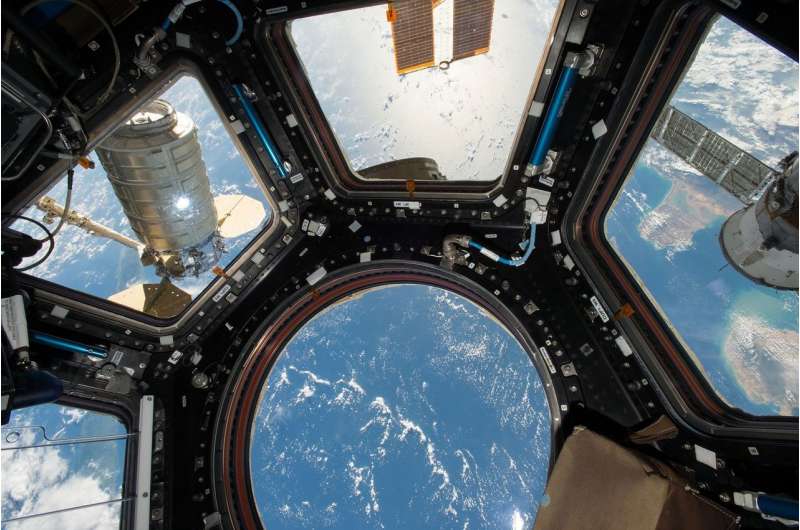Spaceflight accelerates human stem cell aging, researchers find

Sadie Harley
scientific editor

Robert Egan
associate editor

Researchers from the University of California San Diego Sanford Stem Cell Institute have discovered that spaceflight accelerates the aging of human hematopoietic stem and progenitor cells (HSPCs), which are vital for blood and immune system health.
In a study published in Cell Stem Cell, the team used automated artificial intelligence (AI)-driven stem cell-tracking nanobioreactor systems in four SpaceX Commercial Resupply Services missions to the International Space Station (ISS) to track stem cell changes in real time.
The findings show that the cells lost some of their ability to make healthy new cells, became more prone to DNA damage and showed signs of faster aging at the ends of their chromosomes after spaceflight—all signs of accelerated aging.
"Space is the ultimate stress test for the human body," said Catriona Jamieson, M.D., Ph.D., director of the Sanford Stem Cell Institute and professor of medicine at UC San Diego School of Medicine.
"These findings are critically important because they show that the stressors of space—like microgravity and cosmic galactic radiation—can accelerate the molecular aging of blood stem cells.
"Understanding these changes not only informs how we protect astronauts during long-duration missions but also helps us model human aging and diseases like cancer here on Earth. This is essential knowledge as we enter a new era of commercial space travel and research in low Earth orbit."

Previous NASA studies have shown that spaceflight can affect immune function and telomere length. One such study—the NASA Twins Study—was a landmark, year-long experiment (2015–2016) where astronaut Scott Kelly spent 340 days aboard the ISS while his identical twin, Mark Kelly, remained on Earth.
The study tracked changes across genetics, physiology, cognition and the microbiome and found altered gene expression, shifts in telomere length and changes in the gut microbiome.
However, many of these changes reversed or returned to normal after astronaut Kelly returned to Earth. The study did identify some persistent changes, such as increased numbers of short telomeres and disruptions in gene expression, which could be relevant for longer space missions.
This UC San Diego-led study builds on the findings of the Twins Study and the seminal work of the Space Omics and Medical Atlas group, which published 44 scientific papers on aerospace medicine and space biology in Nature. By focusing specifically on HSPCs, the study provided a detailed mechanistic look at how space triggers molecular aging, something the Twins Study hinted at but could not fully explore at the cellular level.
To conduct the study, researchers—including Space Tango—developed a novel "nanobioreactor" platform—miniaturized 3D biosensing systems that allowed human stem cells to be cultured in space and monitored with AI-powered imaging tools.
The study's findings:
- Human HSPCs exposed to 32 to 45 days of spaceflight showed hallmark features of aging. Researchers observed that spaceflight triggers a range of changes in blood-forming stem cells that closely resemble what happens to these cells as we age. The cells became more active than normal, burning through their reserves and losing the ability to rest and recover—a key trait that allows stem cells to regenerate over time.
- Their ability to make healthy new cells declined, while signs of molecular wear-and-tear, like DNA damage and shorter chromosome ends (telomeres), became more pronounced.
- The cells also showed signs of inflammation and stress inside their mitochondria—the cell's energy producers—and began activating hidden sections of the genome that are normally kept quiet to maintain stability. These stress responses can impair immune function and increase the risk of diseases.
Notably, when these space-exposed cells were later placed in a young, healthy environment, some of the damage began to reverse, suggesting it may be possible to rejuvenate aging cells with the right interventions.
These findings have implications not just for astronaut health, but also for understanding the mechanisms of aging and age-related diseases like cancer on Earth.
They underscore the need for new countermeasures to protect stem cell function during extended space missions and support the development of biological markers to detect stress-induced aging early.
"We're excited this breakthrough work is being published to the wider scientific and space communities," said Twyman Clements, president and co-founder of Space Tango.
"Like many accomplishments, this one was a team effort bringing together the Integrated Space Stem Cell Orbital Research Center within SSCI, Space Tango and others. Coupling Space Tango's CubeLab capabilities, specifically the persistent microscopy, has enabled this work and will continue to do so in the future."
The research team plans to extend this work with additional ISS missions and astronaut-based studies, focusing on real-time monitoring of molecular changes and potential pharmaceutical or genetic countermeasures to protect human health in space and beyond. To date, the SSCI has conducted 16 missions to the ISS.
"Space experiments are so complex that they force you to do better science on the ground," continued Jamieson.
"Space research has accelerated technological advancements on Earth, making ground-based research easier and more relevant to human health. What we have learned about cancer from our in space is absolutely remarkable."
More information: Cell Stem Cell (2025).
Journal information: Cell Stem Cell , Nature
Provided by University of California - San Diego




















